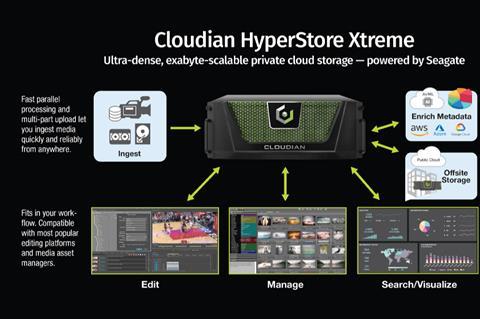The number and variety of hybrid cloud solutions continues to grow as broadcasters seek more flexible ways of working – a requirement given greater urgency by Covid-19, writes David Davies.
Can you briefly outline your current offering in the hybrid cloud space?
Tom Rosenstein, vice president of business development, EditShare: EditShare provides the storage and media management capabilities for on-premise, cloud or hybrid deployments. We recently introduced EFSv, the cloud-based platform made up of the EFS platform and our FLOW media management solution. This platform is enabling our customers to move their workflows to the cloud. As a part of EFSv, we recently announced our seamless proxy editing feature, which enables a cost-optimised cloud infrastructure. Our hybrid solution bridges the gap between cloud and on-premise environments by using the power of FLOW to allow our customers to move the workflows from on-premise to the cloud and back again.

David Phillips, M&E solutions architect, Cloudian: Cloudian brings tremendous flexibility to hybrid cloud deployments, offering both the ability to run our HyperStore software on each of the major vendors’ platforms as well the ability to tier data to each of the ‘Big 3’ cloud services. In fact, we are one of the few private object storage platforms that can tier data to all three major public clouds, and that is what we see most of our customers deploying – some combination of private on-prem Cloudian with data tiered to a public cloud service. Also, more and more enterprises are realising that they are best positioned for the long-term with a hybrid cloud design that incorporates multiple cloud services. This multi-cloud aspect provides access to services that may be unique to a specific vendor as well as financial leverage during contract negotiations.
Julian Fernandez-Campon, CTO, Tedial: Using Tedial’s Evolution MAM with aSTORM, the company’s dynamic content management solution that is agnostic to storage tiers (on-premise live storage, nearline storage, deep archive tape libraries or public cloud storage), media companies can achieve a secure and successful hybrid cloud approach. Hybrid cloud leverages a mixed computing storage and services environment that combines on-premise infrastructure (and/or private cloud services) and a public cloud with orchestration among these various platforms. aSTORM provides the ‘link’ between various storage and hosting scenarios available today and in the future.

What are the primary benefits of your hybrid cloud solution, and what differentiates it from others now available?
Rosenstein: Cloud, on-premise, NLE, opex or capex – the ‘right’ choice is different for everyone. Our customers can choose to migrate a portion of their workflow to the cloud or go ahead and make the full jump. For those customers looking for incremental change, and to protect existing investments we offer cloud-based business continuity solutions. Cost-effectively storing backups and mirroring asset management data in the cloud, we bring the resiliency of the cloud to on-premise environments and allow for cloud-based editing if the need arises. Extending from there, we offer solutions for proxy-based editing in the cloud or remotely against existing on-premise proxies. This allows seamless proxy editing, enabling editors to do their jobs wherever they happen to be with the easy toggle of a switch.
Phillips: Most of the media space customers that we talk to are in the early stages of a larger digital transformation initiative, whether that means migrating from legacy tape archives or virtualising legacy systems and in the process also consolidating their storage infrastructure. In this context, Cloudian’s on-prem object storage provides an easier on-ramp to a larger cloud-native strategy compared to a wholesale ‘lift and shift’ onto public cloud infrastructure. Also, our HyperStore platform provides a unique market differentiator in that it is a completely native implementation of the S3 API. This means we can provide the highest level of S3 interoperability with other services in the media pipeline.
Fernandez-Campon: Key advantages of Tedial’s solution for the hybrid cloud include: abstraction of the physical media location, which makes the definition and implementation of workflows really simple as the operator just requests content and doesn’t have to be aware of or record the physical media path; applications designed in HTML5 using the latest development tools, which maximise the user experience; use of advanced streaming services with MPEG-DASH and multi-resolution; and scalability.

Which factors tend to lead customers to opt for a hybrid cloud solution?
Rosenstein: Customers have long been asking for workflow flexibility. Whether that means hiring editors from remote geographies or simply letting their employees and contractors work from home, production houses no longer want to be tethered to their machines. COVID-19 has only accelerated this request.
- Read more: Looking to the cloud during lockdown
Phillips: Media organisations with large content libraries of long-term value are often best served storing an on-prem copy of their assets, with the driving factors being cost, performance and security. When storing assets that are regularly redistributed and monetised over periods of five years or more, a simple financial analysis proves out that on-prem is more cost-effective than continual public cloud consumption. As far as performance, the pace of high-volume production environments often preclude public cloud solutions that rely on the available ISP bandwidth outside the on-prem LAN.
An interesting phenomenon that we have seen in recent years is a move to repatriate assets back to on-prem, often coming several years after an organisation kicks off a top-down, cloud-first initiative. Total spend on a pure cloud workflow can be hard to model and predict when every aspect of multiple large workflows, from bandwidth to API calls to egress, is metered and charged. Several years into a pure public cloud deployment the total cost almost always exceed predictions, and that is when a hybrid solution starts to look more attractive.
Fernandez-Campon: The main reason for moving to a hybrid cloud approach is that it offers media companies the ability to meet business objectives quickly while maintaining full control of media archives and costs, and ensures a low-risk transition into the cloud by moving the operation in-line with business needs. Hybrid cloud architecture also reduces the total cost of ownership. Capex is lower as the upfront investment is calculated based on the nominal usage and not for peaks, which allows the broadcaster to keep the investment at the desired level. In 2020, on-premise costs of deep archive management (tape library) will continue to be lower than the public cloud as the download costs from the public cloud are still a key factor when production teams require constant download (full or partial) from the archive. This is especially true when UHD content is considered.
- Read more: Studios make move to the cloud
What implications does hybrid cloud have for the protection of assets, and what steps have you taken to enhance your security provisions?
Rosenstein: One of the prevailing misconceptions of cloud-based solutions within the video production market is that the cloud is less secure. This couldn’t be farther from the truth. Using the services offered by public cloud solutions, such as Identity and Access Management services, as well as configuring for private sub-nets, encryption of content at rest and in transit, along with other best practices cloud security greatly exceeds the typical on-premise environment. What we’ve seen in the market is content is most often at risk when it’s moved around from facility to facility, desk to desk. Using cloud environments, the content can remain in place, while controlled access is given to the various workflow stages (post, VFX, audio, etc) in a secure, audited environment.
Phillips: Securing and protecting valuable assets has become a key driver in adopting hybrid cloud designs. For many organisations, their media library represents their ‘crown jewels’ with any leaks or ransomware attacks representing real and immediate negative financial impact. Nowadays it seems that reports of data breaches from ‘leaky’ public cloud buckets occur on a regular basis. Since our HyperStore platform is deployed at multiple agencies of the US Federal Government, Cloudian undertook the rigorous and demanding security validation process required by the National Institute of Standards and Technologies for FIPS 140-2 Level 1 certification. Also, we recently released support for S3 Object Lock with HyperStore v7.2. When data is written to a bucket configured with S3 Object Lock, those objects become immutable and thus impervious to encryption via ransomware attacks.
Fernandez-Campon: Our solution is designed using security best practices such as multiple networks (private, public), use of temporary tokens, links or signed URLs, and it’s regularly tested with penetration tests to make sure content is not leaked from the system. In addition, all users are defined profiles that determine what they can see and do, which means they can’t directly access any of the media locations available in the system.




























No comments yet